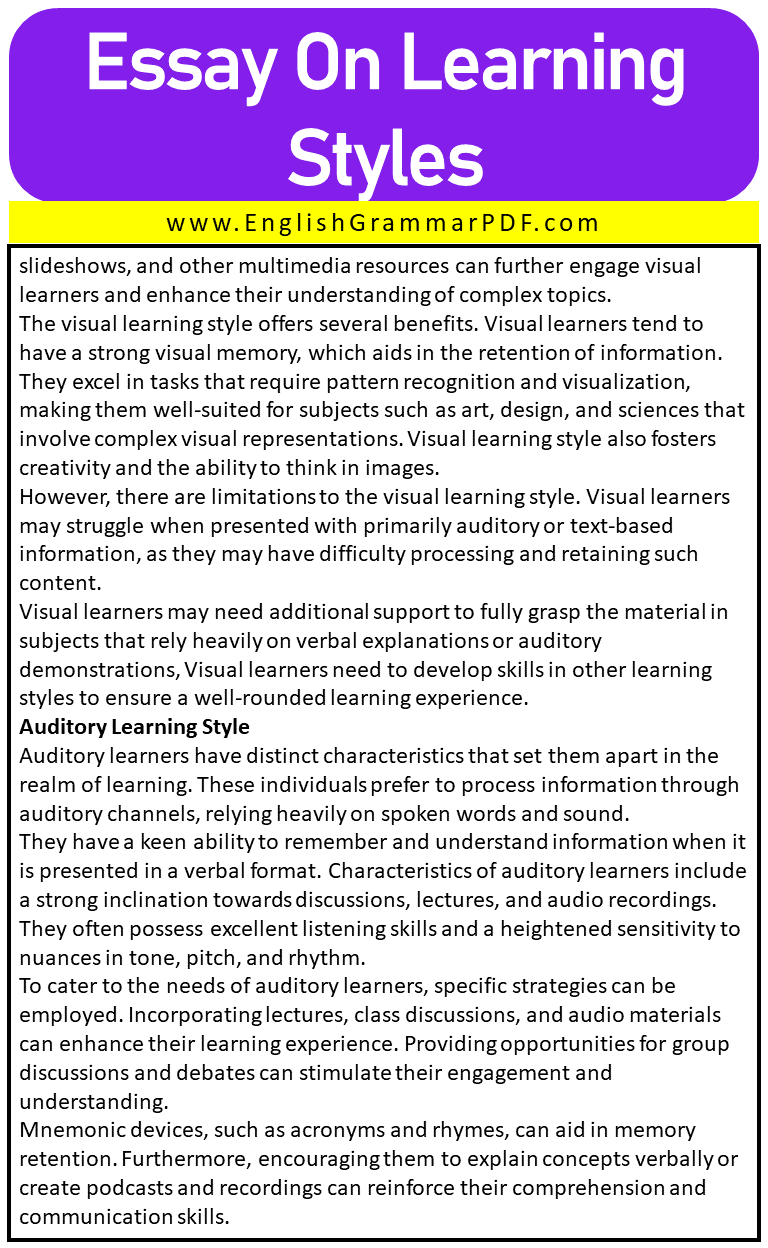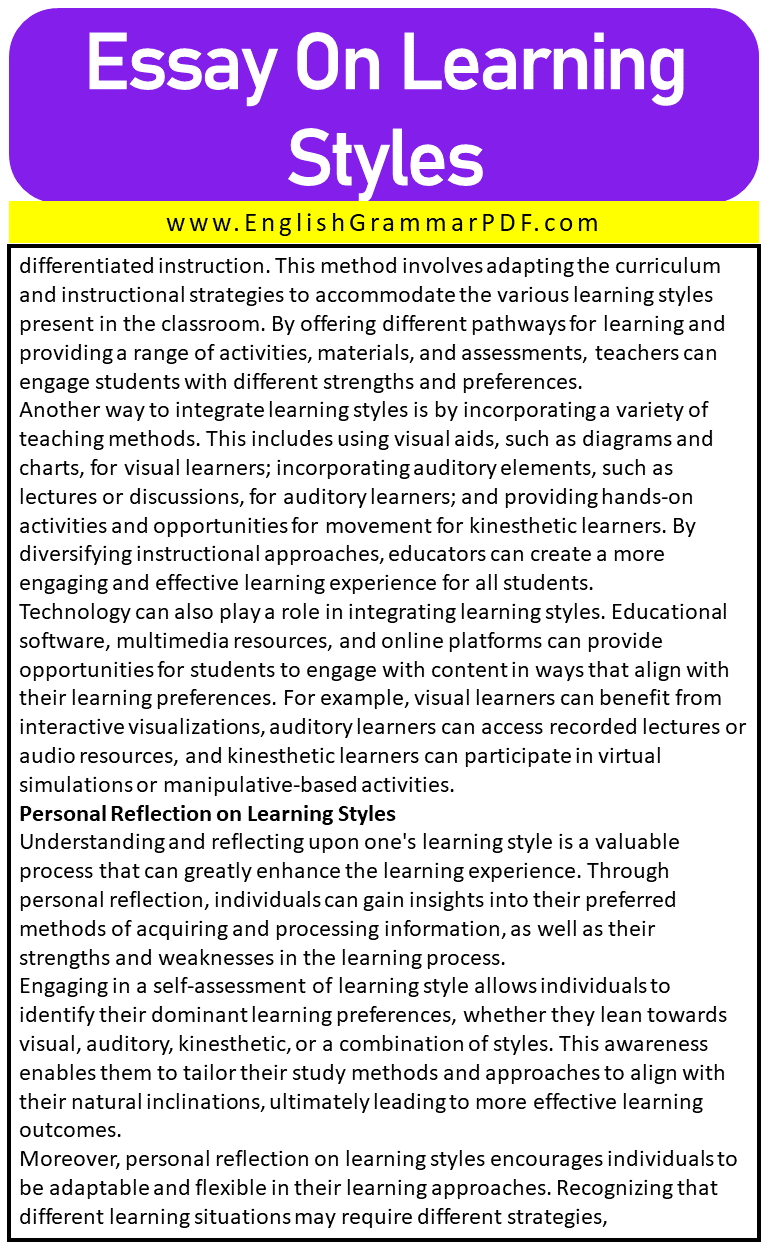Essay On Learning Styles
Outline of Essay:
- Introduction
- Visual Learning Style
- Auditory Learning Style
- Kinesthetic Learning Style
- Critiques and Controversies Surrounding Learning Styles
- Integrating Learning Styles in Education
- Personal Reflection on Learning Styles
- Practical Applications of Learning Styles
Introduction
Learning styles refer to the different ways individuals prefer to process and retain information. Recognizing and understanding these styles is crucial for educators and learners alike, as it enables the tailoring of teaching methods and materials to optimize learning outcomes. This essay explores various theoretical perspectives on learning styles, including visual, auditory, and kinesthetic approaches. It also examines the benefits and limitations of each style, critiques and controversies surrounding the concept of learning styles, integrating learning styles in education, personal reflections, and practical applications in different contexts.
Visual Learning Style
Visual learners have distinct characteristics that set them apart from other learning styles. They have a strong preference for visual aids and rely heavily on visual stimuli to process and retain information. Visual learners are often adept at recognizing patterns, interpreting graphs and charts, and having a keen eye for detail. They are drawn to visual arts, such as drawing and painting, and have a natural ability to visualize concepts and ideas.
To cater to the needs of visual learners, educators can employ various strategies. Utilizing visual aids, such as diagrams, charts, and images, helps to present information in a visually engaging manner. Mind maps and graphic organizers are effective tools for visual learners to organize their thoughts and make connections between different concepts.
Color-coding techniques can be employed to enhance visual memory and facilitate information recall. Additionally, incorporating videos, slideshows, and other multimedia resources can further engage visual learners and enhance their understanding of complex topics.
The visual learning style offers several benefits. Visual learners tend to have a strong visual memory, which aids in the retention of information. They excel in tasks that require pattern recognition and visualization, making them well-suited for subjects such as art, design, and sciences that involve complex visual representations. Visual learning style also fosters creativity and the ability to think in images.
However, there are limitations to the visual learning style. Visual learners may struggle when presented with primarily auditory or text-based information, as they may have difficulty processing and retaining such content.
Visual learners may need additional support to fully grasp the material in subjects that rely heavily on verbal explanations or auditory demonstrations, Visual learners need to develop skills in other learning styles to ensure a well-rounded learning experience.
Auditory Learning Style
Auditory learners have distinct characteristics that set them apart in the realm of learning. These individuals prefer to process information through auditory channels, relying heavily on spoken words and sound.
They have a keen ability to remember and understand information when it is presented in a verbal format. Characteristics of auditory learners include a strong inclination towards discussions, lectures, and audio recordings. They often possess excellent listening skills and a heightened sensitivity to nuances in tone, pitch, and rhythm.
To cater to the needs of auditory learners, specific strategies can be employed. Incorporating lectures, class discussions, and audio materials can enhance their learning experience. Providing opportunities for group discussions and debates can stimulate their engagement and understanding.
Mnemonic devices, such as acronyms and rhymes, can aid in memory retention. Furthermore, encouraging them to explain concepts verbally or create podcasts and recordings can reinforce their comprehension and communication skills.
The benefits of the auditory learning style are evident. Auditory learners excel in verbal communication and are often skilled in public speaking and debates. They can easily follow spoken instructions and lectures, making them effective listeners. Additionally, they have an affinity for music and sound, which can be utilized to enhance their learning experiences.
Kinesthetic Learning Style
Kinesthetic learners, also known as tactile learners, have distinct characteristics that shape their preferred approach to learning. These learners have a strong preference for physical experiences and hands-on activities. They learn best when they can engage their sense of touch and movement in the learning process.
Characteristics of kinesthetic learners include a need for physical interaction with the environment, a preference for manipulating objects, and a tendency to learn by doing. They excel in activities that involve hands-on exploration, such as experiments, simulations, and role-playing. Kinesthetic learners have a heightened sense of body awareness and often demonstrate exceptional motor skills.
Strategies that cater to kinesthetic learners involve creating opportunities for physical engagement and sensory experiences. These strategies include incorporating practical experiments, providing hands-on materials and manipulatives, encouraging movement during learning activities, and incorporating kinesthetic elements into lessons, such as using gestures or acting out scenarios.
The benefits of the kinesthetic learning style are numerous. Kinesthetic learners tend to have excellent physical coordination, problem-solving abilities, and memory recall when information is associated with physical movements. They are often skilled at performing tasks that require motor skills and can excel in fields such as sports, performing arts, and hands-on professions.
Critiques and Controversies Surrounding Learning Styles
The concept of learning styles has faced scrutiny and generated debates among educators and researchers. Several critiques and controversies surround learning styles, highlighting potential limitations and challenges.
Firstly, one of the main criticisms is the lack of strong empirical evidence to support the effectiveness of learning styles in improving learning outcomes. While anecdotal evidence and self-reporting may suggest that individuals have preferred learning styles, studies examining the direct impact of teaching methods tailored to specific learning styles have yielded mixed results. The absence of robust scientific evidence has led some skeptics to question the validity and practicality of implementing learning styles in educational settings.
Secondly, critics argue that learning styles can lead to overgeneralization and oversimplification. The categorization of learners into distinct visual, auditory, or kinesthetic overlooks the complexity of individual learning preferences and the interplay between various sensory modalities.
Humans are multifaceted learners, and their preferences can vary depending on the subject matter, context, and task at hand. Relying solely on learning styles without considering other influential factors may oversimplify the learning process and hinder the development of a comprehensive instructional approach.
Lastly, it is crucial to recognize the importance of individual preferences and contextual factors in learning. While understanding and catering to learners’ preferences is valuable, it is equally essential to acknowledge that individuals possess a range of abilities and can adapt their learning approaches in different situations.
The context in which learning takes place, such as cultural background, prior knowledge, and instructional methods, can significantly influence the effectiveness of specific learning styles. Emphasizing individual agency and considering contextual factors can provide a more comprehensive understanding of the complex nature of learning.
Integrating Learning Styles in Education
Integrating learning styles in education is essential for creating inclusive and effective learning environments. Recognizing that students have diverse preferences and ways of processing information allows educators to tailor their teaching methods and materials to meet individual needs.
One approach to integrating learning styles is through differentiated instruction. This method involves adapting the curriculum and instructional strategies to accommodate the various learning styles present in the classroom. By offering different pathways for learning and providing a range of activities, materials, and assessments, teachers can engage students with different strengths and preferences.
Another way to integrate learning styles is by incorporating a variety of teaching methods. This includes using visual aids, such as diagrams and charts, for visual learners; incorporating auditory elements, such as lectures or discussions, for auditory learners; and providing hands-on activities and opportunities for movement for kinesthetic learners. By diversifying instructional approaches, educators can create a more engaging and effective learning experience for all students.
Technology can also play a role in integrating learning styles. Educational software, multimedia resources, and online platforms can provide opportunities for students to engage with content in ways that align with their learning preferences. For example, visual learners can benefit from interactive visualizations, auditory learners can access recorded lectures or audio resources, and kinesthetic learners can participate in virtual simulations or manipulative-based activities.
Personal Reflection on Learning Styles
Understanding and reflecting upon one’s learning style is a valuable process that can greatly enhance the learning experience. Through personal reflection, individuals can gain insights into their preferred methods of acquiring and processing information, as well as their strengths and weaknesses in the learning process.
Engaging in a self-assessment of learning style allows individuals to identify their dominant learning preferences, whether they lean towards visual, auditory, kinesthetic, or a combination of styles. This awareness enables them to tailor their study methods and approaches to align with their natural inclinations, ultimately leading to more effective learning outcomes.
Moreover, personal reflection on learning styles encourages individuals to be adaptable and flexible in their learning approaches. Recognizing that different learning situations may require different strategies, individuals can consciously expand their repertoire of learning methods and experiment with new techniques. This adaptability allows for a more versatile and well-rounded learning experience, ensuring that individuals can thrive in diverse educational and professional settings.
Practical Applications of Learning Styles
Practical applications of learning styles encompass a wide range of contexts, including education, professional development, and personal growth. Understanding and accommodating diverse learning styles can greatly enhance the effectiveness of learning experiences and improve outcomes in various areas.
In education, practical applications of learning styles involve tailoring teaching methods and materials to cater to different learners. Educators can employ a variety of strategies such as visual aids, hands-on activities, group discussions, and multimedia resources to engage and support students with different preferences. By recognizing and addressing individual learning styles, teachers can create inclusive and dynamic classrooms that promote active learning and knowledge retention.
In the workplace, practical applications of learning styles are crucial for training programs and professional development initiatives. Organizations can identify employees’ preferred learning styles and design training materials and activities that align with those styles. This approach enhances the effectiveness of training, improves skill acquisition, and boosts employee engagement and job satisfaction.
On a personal level, understanding one’s learning style can guide individuals in developing effective study techniques and improving their learning experiences. By leveraging their preferred style, individuals can customize their learning approaches, optimize information retention, and increase their overall learning efficiency.
Furthermore, embracing diverse learning styles promotes lifelong learning and personal growth. By recognizing and respecting different ways of processing and retaining information, individuals can cultivate a deeper appreciation for learning, explore new areas of interest, and continuously develop their knowledge and skills.
FAQ’s
What is the importance of learning styles in learning?
Understanding learning styles is important because it helps tailor teaching methods to individual preferences, enhancing engagement, information retention, and overall learning outcomes.
How do you use learning styles effectively?
To use learning styles effectively, educators can employ strategies such as visual aids, hands-on activities, group discussions, and multimedia resources to cater to diverse learners’ preferences and optimize their learning experiences.
Explore More Essays:
Download the PDF of the Essay:









